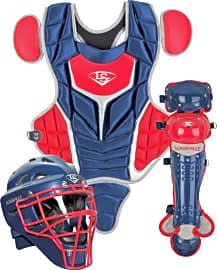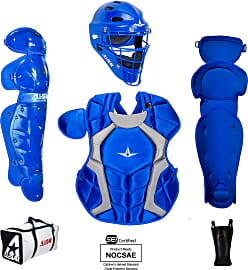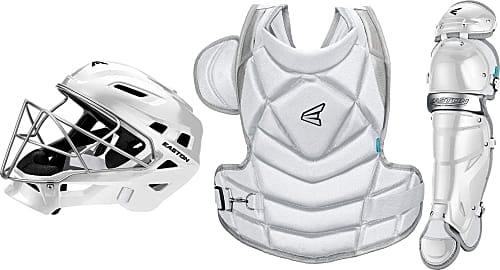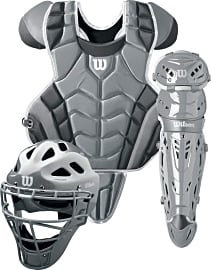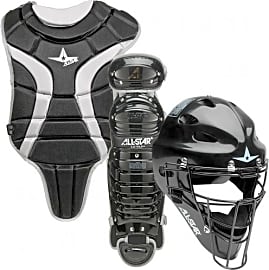The 10 Best Youth Catcher Sets

This wiki has been updated 39 times since it was first published in July of 2015. Before sending your kids out to face a pitch, make sure they have the right protective gear to prevent injuries when they're behind the plate. These youth catcher sets typically include a helmet, a chest protector and leg guards, and some also come with additional items like throat guards and travel bags. They are available in a range of colors and styles to suit children of various ages. When users buy our independently chosen editorial selections, we may earn commissions to help fund the Wiki.
Editor's Notes
July 02, 2020:
Eliminated a couple items due to quality and availability concerns. Updated a listing from Easton and another from Under Armour to the newest available versions, resulting in the addition of the Easton Gametime and Under Armour PTH Victory. These are both high-quality options that offer ample adjustability, which is helpful for both comfort and range of motion.
We’ve also noted that the MacGregor Junior is suitable for both young boys and girls, and that the straps for the leg guards that come with the All-Star League Series may become loose and shift around during gameplay. We downgraded the latter slightly as a result.
Added two additional sets from Easton, one of which (the Easton Fundamental) is designed specifically for young female catchers. The Easton Elite X is offered in a wide variety of color combinations, making it a good choice if you’re attempting to match your child’s gear to the team uniform he or she will be wearing.
Some kits, like the All-Star Intermediate, MacGregor Junior and Under Armour PTH Victory, come with special throat guards, but in many cases, this is something you’ll have to purchase separately.
Special Honors
MaxBat Gear From an American bat-making company, this set contains tough shin guards (which feature removable toe guards), a chest protector with adjustable shoulders, and a heavy-duty mask that resembles that of a hockey player. You can choose from a black or silver cage mask. maxbats.com
A Brief History Of Catching Equipment
He was roundly mocked by fans, who started throwing snowballs and forced the game's cancellation.
Being a catcher can be hazardous to your health. You have to deal with errant fastballs, careless swings of the bat, and the occasional freight train barreling down on you from third base. It's no wonder, then, that catchers are only slightly less armored than your standard rhinoceros.
It wasn't always this way. When baseball was invented, the catcher stood well behind the batter and attempted to catch the pitcher's underhanded toss off the bounce. Nat Hicks of the New York Mutuals was the first backstop to move closer to the batter's box, and his courage was rewarded with repeated blows to the face and the near-loss of his right eye.
By the time pitchers started throwing overhand in 1884, most catchers wanted to be nearer to the action, but they also wanted to keep their eyes intact. As a result, a catcher at Harvard donned the first face protector — a fencing mask — and they soon became ubiquitous. Apparently, it took an Ivy League education to deduce that taking a fastball to your unprotected mug is bad for your health.
Since then, there has been a concerted effort to design a perfect mask, but it's proven difficult to create headgear that offers sufficient protection without obscuring vision. The most recent prototype is a lightweight model that's similar to a hockey mask, and deflects the impact of the ball instead of absorbing it, which is significant considering the recent concern over the long-term health effects of concussions.
Mitts have also undergone quite a few facelifts (handlifts?) over the years. The first gloves were simple mittens, but again, that was for catching underhanded tosses after they bounced. Once pitchers like Walter Johnson began to bring the heat, padded gloves became a necessity. The pillow mitt took over in the late 19th century up until the 1920s, when it was replaced by flexible gloves that allowed catchers to grab the ball. Since then, the hinge mitt has taken over, as it allows for one-handed catching.
As for shin guards and chest protectors, those were first sported by Hall of Famer Roger Bresnahan in 1907. He was roundly mocked by fans, who started throwing snowballs and forced the game's cancellation. Other catchers took notice, however, and wearing protection became commonplace.
Their basic design has stayed fairly consistent, with modifications made to allow for better protection and increased mobility. Baseball is always on the lookout for superior armor, however, and has even begun to experiment with the Kevlar that's found in bulletproof vests.
After all, if a chest protector can stop a bullet, it might be able to stop a Nolan Ryan fastball as well.
Picking Out The Right Gear For Your Child
If your kids have the makings of big-league backstops, then it's important to keep them safe when they're behind the plate. Below are a few things to look for when picking out your child's gear.
It's important to check with your league before making a purchase, as traditional masks are often banned at lower levels of play.
First off, you need to decide which type of mask you prefer. The traditional mask is easy to slip off quickly and gives a wide field of view, while the hockey-style model offers superior protection. It's important to check with your league before making a purchase, as traditional masks are often banned at lower levels of play.
When scoping out chest protectors, you can choose between models designed for baseball or softball. The baseball options will have a removable groin protector, while the softball models are cut to better accommodate the female form. Regardless of which you choose, ensure that your child can comfortably chest-bump the home plate umpire whenever he blows a call.
For leg guards, the most important things are comfort and flexibility. Take the time to try them on and really put them through their paces, as your kid won't want to have to endure a whole game in gear that pinches or rubs them raw. If buying online, measure your child with a tape measure before ordering, and try to stick within a half-inch of your kid's measurements.
Once your child is properly equipped, you can rest assured you've done your best to prevent injuries. Now, all that's left to worry about is the best way to heckle the other team's pitcher.
Other Ways To Keep Your Kids Safe On The Field
Buying the right protective gear is a good start, and, while you can never ensure that your kid is completely safe on the diamond, there are a few additional precautions you can take in order to minimize the likelihood of an injury.
Encourage your child to speak up if they have any aches or pains, as ignoring an injury is the best way to worsen it.
It's important to make sure that all players are relatively equal in size and skill. While you may see 12-year-olds with full beards competing in the Little League World Series every year, having a child play against bigger competition is a recipe for disaster.
Likewise, teach your kid to play the game the right way. This includes not blocking the plate, not spiking opponents (or allowing themselves to be spiked), and using proper throwing motions.
Encourage your child to speak up if they have any aches or pains, as ignoring an injury is the best way to worsen it. Pay attention to how the coach responds as well; if they don't take your kid's concerns seriously, you may be better off finding another team. After the game, you can help speed up the healing process by tending to injuries with heat or ice.
While you want your child to be safe, try not to be overprotective, either. By all means, take precautions to prevent injuries, but then at some point you have to just let them play. Just remember that it's a beautiful game, and you don't want to ruin it for your kid by being that parent.


